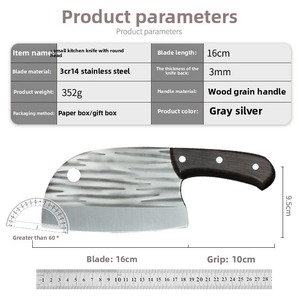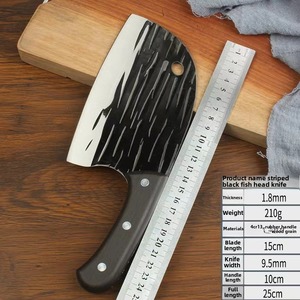
All categories
Featured selections
Trade Assurance
Buyer Central
Help Center
Get the app
Become a supplier

(21802 products available)














A bone-cutting machine is an essential piece of equipment. The types of bone cutter machines can be categorized based on their functionalities, power sources, sizes, and design features.
The specifications of the meat bone cutting machine vary according to its types and capabilities. Here are some key specifications along with their maintenance needs:
Cutting capacity
Cutting capacity refers to the amount of product the machine can process per unit of time. It is measured in pounds per hour or kg per hour. Users can maintain the performance of the bone cutter machine by limiting the cutting capacity and ensuring it is not exceeded. Additionally, they can schedule regular maintenance of the machine.
Cutting speed
It refers to the speed at which the machine cuts bones. It is measured in revolutions per minute (RPM). To maintain the cutting speed of the bone cutter machine, the blade should be sharp. A dull blade tends to cut slowly and produce rough cuts. Secondly, the machine should be properly lubricated. This allows for smooth and fast operation.
Power Source
The power source of the bone cutter machine varies and can be electric, hydraulic, or manual. Users can maintain the power source by regularly checking the electrical connections. This ensures that there is no loose connection that could affect the operation. More to that, users should avoid overloading the machine as this can strain the motor and damage the power source.
Cutting Blade
The bone cutting machine comes with different types of cutting blades. Some are used to cut bones only, while others are used to cut both bones and meat. The maintenance of the cutting blade depends on its type. However, users should ensure that the blades are always sharp to maintain the quality of the cuts.
Size and Weight
Generally speaking, the size and weight of the bone cutter machine affect its portability. However, users can maintain the machine's portability and maneuverability by lifting the machine with two or more people. This reduces the risk of injury and accidents. Depending on the model, users can also use moving parts such as wheels and casters.
The bone cutting machine demonstrates an extensive array of usage scenarios across the food processing and veterinary industries. In the first scenario, bone cutter machines for the kitchen, whether electric or manual, remain essential tools for chefs and restaurant managers. They enable wholesome stocks and broths to be made. Such high-performing machines can also bean muscle food like beefsteaks, pork, and lamb cuts. Not only do they increase productivity, but they also cut down on time.
Meanwhile, in industrial food processing units, large, powerful electric bone cutting machines are used to prepare pet food and animal therapy for livestock. They are also -depending on their processing capacity- used in residential and commercial kitchens for the exact purposes as previously mentioned. Food processing units also use them to produce bone meal for fertilizer, which is the third usage scenario. Bone meal contains high concentrations of calcium, phosphorus, and other nutrients beneficial to plants.
The last scenario involves the veterinary and biomedical industries. There, specialized machines are required to ensure bone samples for research or animal treatment are cut uniformly. These may also have an advanced digital control system that can store and recall cutting protocols. Such machines typically produce smooth cuts with no bone dust, which is critical in achieving accurate results and animal welfare.
Some of the factors to consider when bone cutting machine are:
Construction material
A stainless steel bone cutting machine is a popular choice because it is easy to clean. Stainless steel machines also fulfill industry food safety standards. Nevertheless, businesses may come across if not, all machines constructed from stainless steel. Some will have stainless steel components, while others will have only a stainless steel coating. Businesses can tell if a machine is entirely stainless steel by checking the material specifications to ensure only the best and safe pieces are used.
Slicing mechanism
Large bone cutter machines often have band saws as slicing mechanisms. That's because band saws are efficient, provide high-speed cuts, and are excellent at handling different cut sizes. Smaller bone-cutting machines will most likely use circular blades as slicing mechanisms. Circular blades are slower and, thus, not ideal for large volumes.
Automation
Automation in bone cutter machines comes in many forms—length, width, height, and thickness—preset cutting dimensions. Besides, Selector switches, push buttons, and emergency shut-off button are all safety controls that ensure operators' safety while handling the machines. Conveyor belts help move the cut pieces to their designated areas. Bone-cutting machines with automatic features are easy to operate. There's no need for constant machine supervision. They improve production speed, cutting accuracy, and consistency.
Noise level
Bone cutting machines can get pretty noisy during operation. Those with large motors and blades are especially notorious for high noise levels. One way to reduce noise is by wearing ear protection. Bone cutter machines with a low noise level are much more comfortable to use than those with a high noise level. Some even allow operators to cut bones for hours without any discomfort. Employers should consider choosing machines with low noise levels to ensure worker comfort.
Power
Horsepower indicates the cutting power of bone cutting machines and how efficiently the machines perform. Even though horsepower is essential, cutting capacity, construction material, thickness of bones, and blade type are relevant factors businesses must consider. A bone cutter machine with sufficient power will efficiently tackle tough bones, reducing the risk of equipment damage.
Q1: How can users ensure the safety of the bone cutting machine?
A1: Users can ensure the machine's safety by following the manufacturer's instructions carefully. Always turn off the machine when not in use and ensure all guards are in place. Avoid cutting bones that are too big for the machine, and never place their hands or any other body parts close to the moving blades. Also, ensure the cutter is well maintained and lubricated to prevent any accidents that may arise from mechanical faults.
Q2: What are the maintenance requirements for a bone cutting machine?
A2: Regular cleaning after each use is crucial to prevent contamination and ensure optimal performance. Periodic lubrication of moving parts helps reduce wear and tear. Also, routinely inspect the blade for sharpening or replacement, and promptly address any mechanical issues that arise to extend the machine's lifespan.
Q3: Does the size of the bone cutter machine affect its performance?
A3: Yes, the machine's size can affect its performance. Generally, larger machines have more powerful motors. They are capable of handling bigger volumes of bone at a go. They also produce faster cutting speeds. However, larger machines are more costly and take up a lot of space. On the other hand, small-sized machines are more affordable and are suitable for small-scale bone cutting.
Q4: Are bone cutter machines suitable for all types of bones?
A4: Not all types of bones are suitable for cutting with a bone cutter machine. Harder bones, such as beef leg bones and pork vertebrae, are more suitable than softer ones, such as chicken bones. Additionally, some bone cutter machines may struggle to cut larger bones. Bone cutters should only attempt to cut them to avoid damaging the machine.
Q5: Can someone customize a bone cutting machine according to their specifications?
A5: Customization of a bone cutting machine is possible. However, it is advisable to consult the manufacturer to discuss specific requirements before proceeding with any changes.